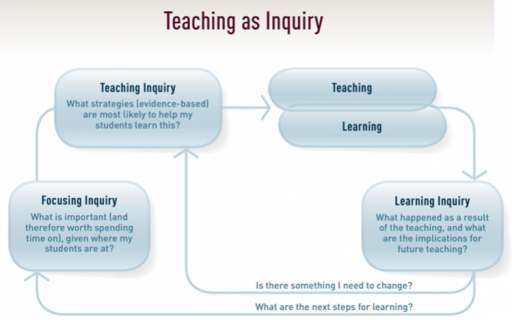"Since any teaching strategy works differently in different contexts for different students, effective pedagogy requires that teachers inquire into the impact of their teaching on their students."
The New Zealand Curriculum, 2007, page 35
Teachers inquire into the teaching–learning relationship “moment by moment (as teaching takes place), day by day, and over the longer term” (page 35). When planning for learning opportunities, you need to carefully consider the needs of all students in your class and the additional support you may require to ensure that their learning needs are met.
Figure 4 shows the teaching as inquiry cycle from The New Zealand Curriculum (page 35). The prompts above and below it help to unpack the three inquiries within the cycle.
Figure 4: Teaching as inquiry
Teaching inquiry
- What teaching and learning tasks and strategies could be used with all students?
- What tasks and strategies have I used before that worked well?
- What adaptations and/or differentiations are required for some of my students? Who can help me identify and implement these?
- How is the lesson progressing? Do I need to modify anything because of what I observe happening for my students?
- Are all my students ready for the next part of the lesson sequence? How do I know?
- In what ways am I supporting student agency?
If you cannot view or read this diagram, select this link to open a text version.
Focusing inquiry
-
What learning area(s) and achievement objectives am
I considering?
- What are the big ideas?
- What are the desired learning outcomes, including key competency development?
- Where are my students currently at with regard to these outcomes? How do I know? What do my students say?
- What prior knowledge and diverse perspectives do my students bring to the teaching and learning context?
Learning inquiry
- How well were students able to understand and achieve the intended learning outcomes? What evidence do I have?
- What was the impact of the differentiations and adaptations I used for some students?
- What have I learnt through feedback from my students?
- What are the next learning steps?
The examples from the classroom in this resource illustrate how teachers have endeavoured to include all students in participating, learning, and achieving alongside their peers. The examples align to the teaching as inquiry model and demonstrate the strategic actions and reflections made by the teacher, students, and their whānau on their learning.
As a group, discuss the questions alongside the two dimensions from the Educultural Wheel below. Add to the questions from your own teaching experience.
| Dimension
| Teacher questions
|
|---|
| Rangitiratanga Teacher effectiveness
|
- In what ways do I advocate for the unique needs of the students in my classroom?
- How effective and enabling is my teaching pedagogy?
- How does my practice and planning unleash the strengths and potential of my students?
- Do I understand the challenges my students face at school?
|
| Kotahitanga Ethic of bonding
|
- How does the culture of the classroom encourage collaboration?
- What opportunities are there for students to work together?
- In what ways am I modeling unity and collaboration in my interactions with others?
|
Next – Differentiation and adaptation
Published on: 19 May 2015
Return to top



